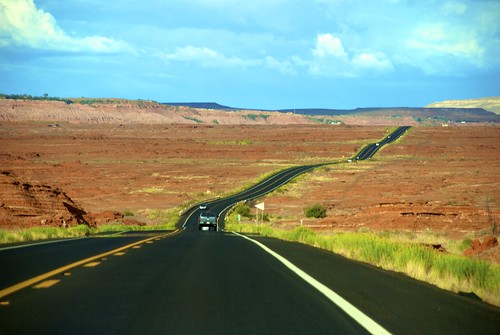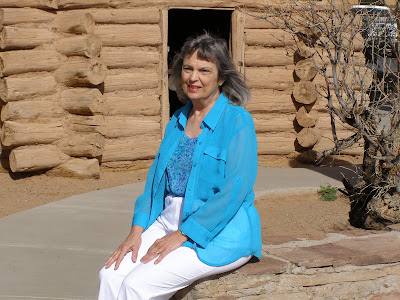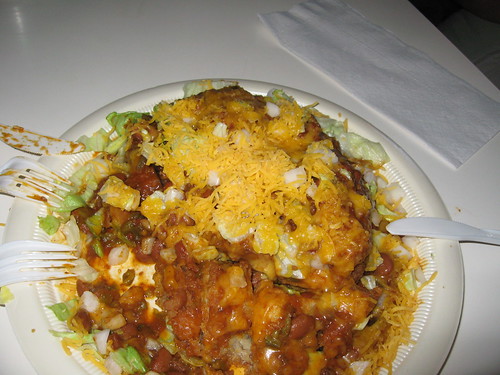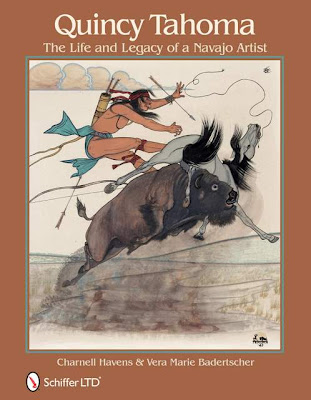Seeing Real Navajos at the Swap Meet
When people visit the Navajo reservation in northern Arizona and New Mexico, they may come looking for "real" Indians--you know, the preserved-in-amber- redskin made familiar in movies. Nothing can drive an American Indian crazier than outsiders who think that all natives look like they looked in 1800, and they live in primitive conditions in a fenced-in reservation. There are no fences. And just as you don't dress and live the way your great-great grandparents did, neither do they.
That said, there is a strong sense of tradition, a pervasive use of the Navajo language (along with English as the first language), and a pride in the fact that Diné (their name for themselves) are, in fact, a nation. The governmental relationship between the United States and the native nations within its boundaries can give you a headache if you really try to figure it out, and as a tourist, you can just be grateful that you do not have to understand too much.

Katy, an elderly Navajo woman from Tahoma's adoptive family, pictured in Tuba City. Photo by Charnell Havens
So driving north from Flagstaff Arizona, onto the reservation, don't expect to see a fence marking the edge of the nation's largest reservation, but don't be surprised to be awed by the spectacular vistas of land and sky that seem to stretch forever. Tune your radio to the Navajo radio station and let the complex, guttural Navajo language wash over you. In several years of trying, I have only been able to remember "hello" Yah-ta-hey, and a word that means beauty, harmony, blessings--hozho. Some teenage girls tried to teach me thank you, so I could thank their great-grandmother for a doll I had bought form her, but they gave up on me. Like some oriental languages, which it slightly resembles, Navajo's intonations are important along with the syllables.

On the road to Tuba City. Flickr photo by http://www.flickr.com/photos/dclemm/4962108704/
The Yah-ta-hey, despite slight mispronunciation, will be taken as friendly when you head into Tuba City, Arizona, on a Friday. Ask anywhere--perhaps at the Tuba City Trading Post which was one of a string started by the family of former Interior Secretary Bruce Babbitt back in the 1800's-- where the Swap Meet is held. If you're bashful, just drive around town--its a small town--until you see a dirt road with rows and rows of four-wheel drive and pickup trucks parked in a dusty lot.

Vera Maire in front of hogan built in front of Tuba City Trading Post.
The Tuba City Swap Meet is where everyone goes on Friday. Smell the grease dripping off roasting mutton, and the fried-flour scent of frybread. Follow elderly women dressed in velvet blouses and loaded down with all the silver and turquoise necklaces and bracelets that their family has accumulated for three generations. She will be walking with a bandy-leg retired cowboy in his silver concho-belted levis and ten-gallon hat circled with a feather or turquoise bead band.
At the tables you can buy everything from t-shirts with rock band logos to housewares to made-in-China Indian jewelry or perhaps even some authentic handcrafted silver stuff. Or get sheepskins ready to stretch for drumheads. You will hear people in their eighties chatting in Navajo because they never bothered to learn English. The women, particularly, may have been considered too useful at home to be sent to school when they were children. And all the time you will be surrounded by "real" Navajo life. This is it.

Navajo Taco. Flickr photo by http://www.flickr.com/photos/weasel-on-wheels/2657508293/
If you aren't too full of mutton stew and roasted corn by the time you leave the Swap Meet, you'll want to have a Navajo taco at Kate's Cafe or at the Hogan restaurant in front of the Quality Inn--both Navajo Nation Enterprises. And that, you see, is also "real" Navajo--entrepreneurs running modern businesses, studying hotel management and the intricacy of the hospitality industry. Welcoming you to Diné Bikeyah--Navajo Land.

Vera Marie Badertscher is co-author with Charnell Havens of Quincy Tahoma: The Life and Legacy of a Navajo Artist. The subject of the biography was born in Tuba City in 1917, and Charnell and Vera Marie went to the Tuba City Swap Meet in search of members of his family.



















